ESP FIAT TIPO 4DOORS 2020 Owner handbook (in English)
[x] Cancel search | Manufacturer: FIAT, Model Year: 2020, Model line: TIPO 4DOORS, Model: FIAT TIPO 4DOORS 2020Pages: 252, PDF Size: 7.29 MB
Page 135 of 252
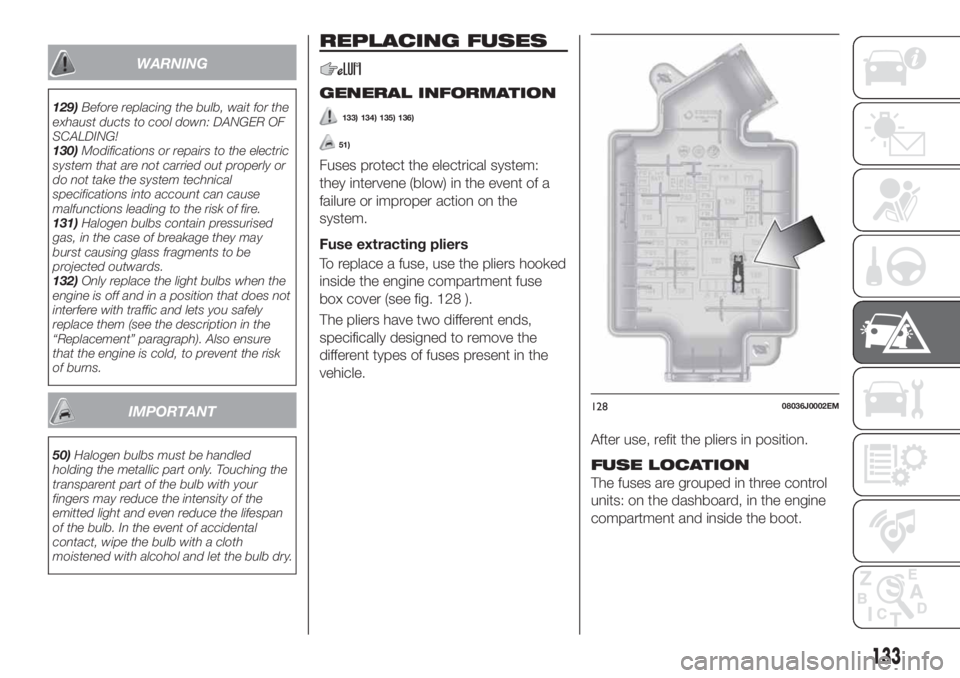
WARNING
129)Before replacing the bulb, wait for the
exhaust ducts to cool down: DANGER OF
SCALDING!
130)Modifications or repairs to the electric
system that are not carried out properly or
do not take the system technical
specifications into account can cause
malfunctions leading to the risk of fire.
131)Halogen bulbs contain pressurised
gas, in the case of breakage they may
burst causing glass fragments to be
projected outwards.
132)Only replace the light bulbs when the
engine is off and in a position that does not
interfere with traffic and lets you safely
replace them (see the description in the
“Replacement” paragraph). Also ensure
that the engine is cold, to prevent the risk
of burns.
IMPORTANT
50)Halogen bulbs must be handled
holding the metallic part only. Touching the
transparent part of the bulb with your
fingers may reduce the intensity of the
emitted light and even reduce the lifespan
of the bulb. In the event of accidental
contact, wipe the bulb with a cloth
moistened with alcohol and let the bulb dry.
REPLACING FUSES
GENERAL INFORMATION
133) 134) 135) 136)
51)
Fuses protect the electrical system:
they intervene (blow) in the event of a
failure or improper action on the
system.
Fuse extracting pliers
To replace a fuse, use the pliers hooked
inside the engine compartment fuse
box cover (see fig. 128 ).
The pliers have two different ends,
specifically designed to remove the
different types of fuses present in the
vehicle.
After use, refit the pliers in position.
FUSE LOCATION
The fuses are grouped in three control
units: on the dashboard, in the engine
compartment and inside the boot.
12808036J0002EM
133
Page 136 of 252
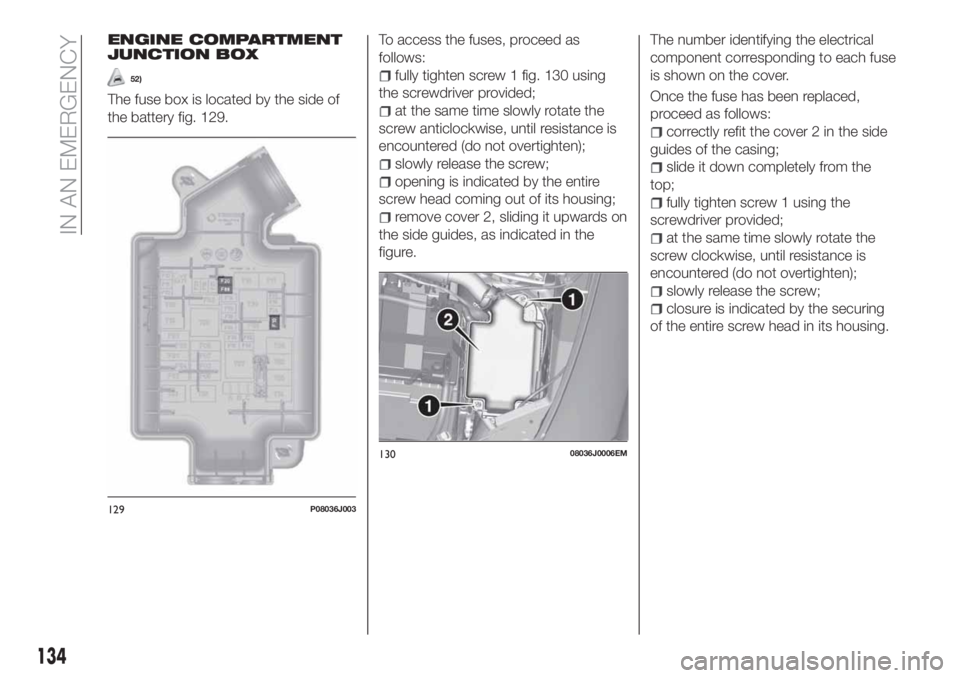
ENGINE COMPARTMENT
JUNCTION BOX
52)
The fuse box is located by the side of
the battery fig. 129.To access the fuses, proceed as
follows:
fully tighten screw 1 fig. 130 using
the screwdriver provided;
at the same time slowly rotate the
screw anticlockwise, until resistance is
encountered (do not overtighten);
slowly release the screw;
opening is indicated by the entire
screw head coming out of its housing;
remove cover 2, sliding it upwards on
the side guides, as indicated in the
figure.The number identifying the electrical
component corresponding to each fuse
is shown on the cover.
Once the fuse has been replaced,
proceed as follows:
correctly refit the cover 2 in the side
guides of the casing;
slide it down completely from the
top;
fully tighten screw 1 using the
screwdriver provided;
at the same time slowly rotate the
screw clockwise, until resistance is
encountered (do not overtighten);
slowly release the screw;
closure is indicated by the securing
of the entire screw head in its housing.
129P08036J003
13008036J0006EM
134
IN AN EMERGENCY
Page 144 of 252
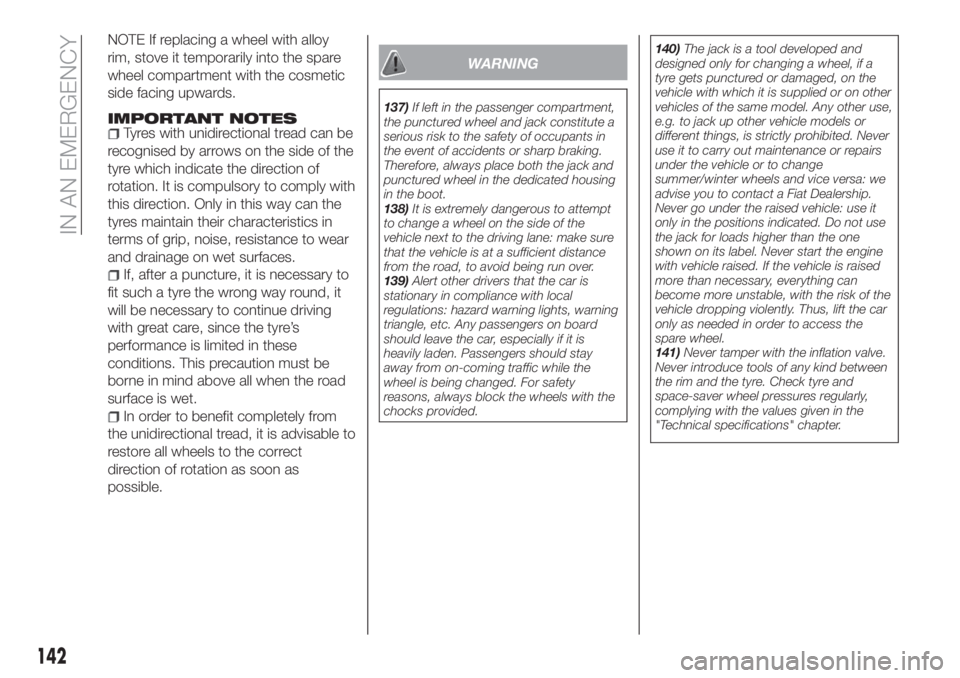
NOTE If replacing a wheel with alloy
rim, stove it temporarily into the spare
wheel compartment with the cosmetic
side facing upwards.
IMPORTANT NOTESTyres with unidirectional tread can be
recognised by arrows on the side of the
tyre which indicate the direction of
rotation. It is compulsory to comply with
this direction. Only in this way can the
tyres maintain their characteristics in
terms of grip, noise, resistance to wear
and drainage on wet surfaces.
If, after a puncture, it is necessary to
fit such a tyre the wrong way round, it
will be necessary to continue driving
with great care, since the tyre’s
performance is limited in these
conditions. This precaution must be
borne in mind above all when the road
surface is wet.
In order to benefit completely from
the unidirectional tread, it is advisable to
restore all wheels to the correct
direction of rotation as soon as
possible.
WARNING
137)If left in the passenger compartment,
the punctured wheel and jack constitute a
serious risk to the safety of occupants in
the event of accidents or sharp braking.
Therefore, always place both the jack and
punctured wheel in the dedicated housing
in the boot.
138)It is extremely dangerous to attempt
to change a wheel on the side of the
vehicle next to the driving lane: make sure
that the vehicle is at a sufficient distance
from the road, to avoid being run over.
139)Alert other drivers that the car is
stationary in compliance with local
regulations: hazard warning lights, warning
triangle, etc. Any passengers on board
should leave the car, especially if it is
heavily laden. Passengers should stay
away from on-coming traffic while the
wheel is being changed. For safety
reasons, always block the wheels with the
chocks provided.140)The jack is a tool developed and
designed only for changing a wheel, if a
tyre gets punctured or damaged, on the
vehicle with which it is supplied or on other
vehicles of the same model. Any other use,
e.g. to jack up other vehicle models or
different things, is strictly prohibited. Never
use it to carry out maintenance or repairs
under the vehicle or to change
summer/winter wheels and vice versa: we
advise you to contact a Fiat Dealership.
Never go under the raised vehicle: use it
only in the positions indicated. Do not use
the jack for loads higher than the one
shown on its label. Never start the engine
with vehicle raised. If the vehicle is raised
more than necessary, everything can
become more unstable, with the risk of the
vehicle dropping violently. Thus, lift the car
only as needed in order to access the
spare wheel.
141)Never tamper with the inflation valve.
Never introduce tools of any kind between
the rim and the tyre. Check tyre and
space-saver wheel pressures regularly,
complying with the values given in the
"Technical specifications" chapter.
142
IN AN EMERGENCY
Page 156 of 252
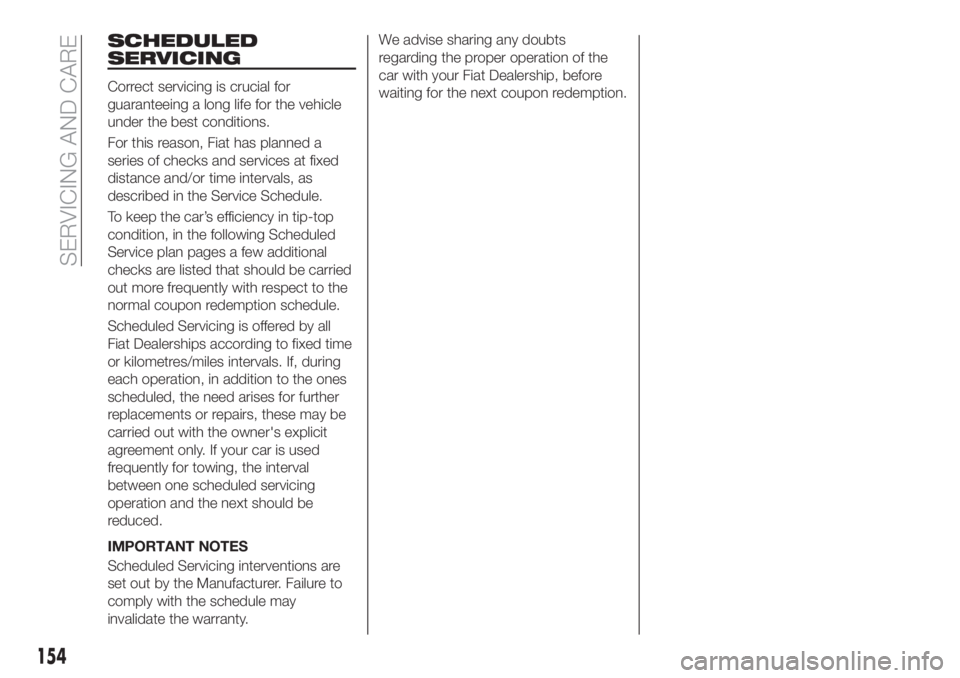
SCHEDULED
SERVICING
Correct servicing is crucial for
guaranteeing a long life for the vehicle
under the best conditions.
For this reason, Fiat has planned a
series of checks and services at fixed
distance and/or time intervals, as
described in the Service Schedule.
To keep the car’s efficiency in tip-top
condition, in the following Scheduled
Service plan pages a few additional
checks are listed that should be carried
out more frequently with respect to the
normal coupon redemption schedule.
Scheduled Servicing is offered by all
Fiat Dealerships according to fixed time
or kilometres/miles intervals. If, during
each operation, in addition to the ones
scheduled, the need arises for further
replacements or repairs, these may be
carried out with the owner's explicit
agreement only. If your car is used
frequently for towing, the interval
between one scheduled servicing
operation and the next should be
reduced.
IMPORTANT NOTES
Scheduled Servicing interventions are
set out by the Manufacturer. Failure to
comply with the schedule may
invalidate the warranty.We advise sharing any doubts
regarding the proper operation of the
car with your Fiat Dealership, before
waiting for the next coupon redemption.
154
SERVICING AND CARE
Page 158 of 252
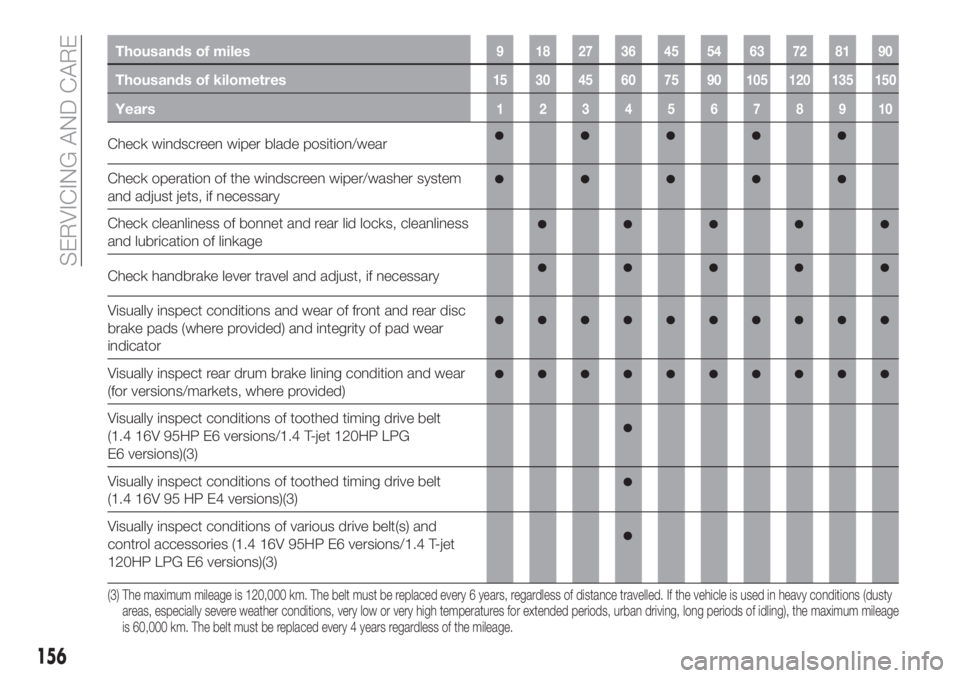
Thousands of miles9 182736455463728190
Thousands of kilometres15 30 45 60 75 90 105 120 135 150
Years12345678910
Check windscreen wiper blade position/wear
Check operation of the windscreen wiper/washer system
and adjust jets, if necessary
Check cleanliness of bonnet and rear lid locks, cleanliness
and lubrication of linkage
Check handbrake lever travel and adjust, if necessary
Visually inspect conditions and wear of front and rear disc
brake pads (where provided) and integrity of pad wear
indicator
Visually inspect rear drum brake lining condition and wear
(for versions/markets, where provided)
Visually inspect conditions of toothed timing drive belt
(1.4 16V 95HP E6 versions/1.4 T-jet 120HP LPG
E6 versions)(3)
Visually inspect conditions of toothed timing drive belt
(1.4 16V 95 HP E4 versions)(3)
Visually inspect conditions of various drive belt(s) and
control accessories (1.4 16V 95HP E6 versions/1.4 T-jet
120HP LPG E6 versions)(3)
(3) The maximum mileage is 120,000 km. The belt must be replaced every 6 years, regardless of distance travelled. If the vehicle is used in heavy conditions (dusty
areas, especially severe weather conditions, very low or very high temperatures for extended periods, urban driving, long periods of idling), the maximum mileage
is 60,000 km. The belt must be replaced every 4 years regardless of the mileage.
156
SERVICING AND CARE
Page 159 of 252
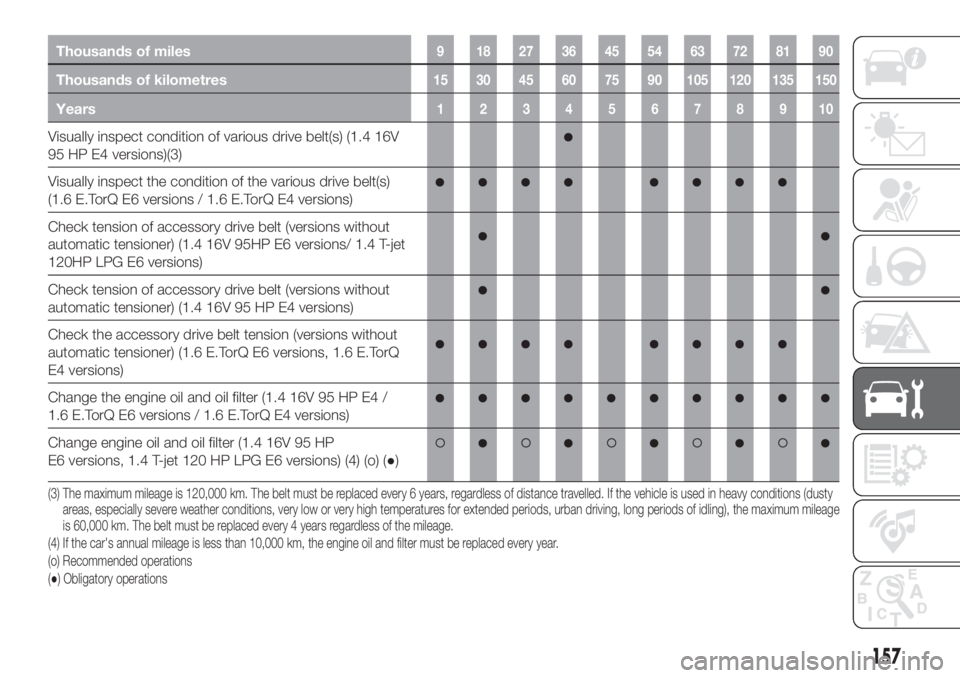
Thousands of miles9 182736455463728190
Thousands of kilometres15 30 45 60 75 90 105 120 135 150
Years12345678910
Visually inspect condition of various drive belt(s) (1.4 16V
95 HP E4 versions)(3)
Visually inspect the condition of the various drive belt(s)
(1.6 E.TorQ E6 versions / 1.6 E.TorQ E4 versions)
Check tension of accessory drive belt (versions without
automatic tensioner) (1.4 16V 95HP E6 versions/ 1.4 T-jet
120HP LPG E6 versions)
Check tension of accessory drive belt (versions without
automatic tensioner) (1.4 16V 95 HP E4 versions)
Check the accessory drive belt tension (versions without
automatic tensioner) (1.6 E.TorQ E6 versions, 1.6 E.TorQ
E4 versions)
Change the engine oil and oil filter (1.4 16V 95 HP E4 /
1.6 E.TorQ E6 versions / 1.6 E.TorQ E4 versions)
Change engine oil and oil filter (1.4 16V 95 HP
E6 versions, 1.4 T-jet 120 HP LPG E6 versions) (4) (o) (●)
(3) The maximum mileage is 120,000 km. The belt must be replaced every 6 years, regardless of distance travelled. If the vehicle is used in heavy conditions (dusty
areas, especially severe weather conditions, very low or very high temperatures for extended periods, urban driving, long periods of idling), the maximum mileage
is 60,000 km. The belt must be replaced every 4 years regardless of the mileage.
(4) If the car's annual mileage is less than 10,000 km, the engine oil and filter must be replaced every year.
(o) Recommended operations
(●) Obligatory operations
157
Page 160 of 252
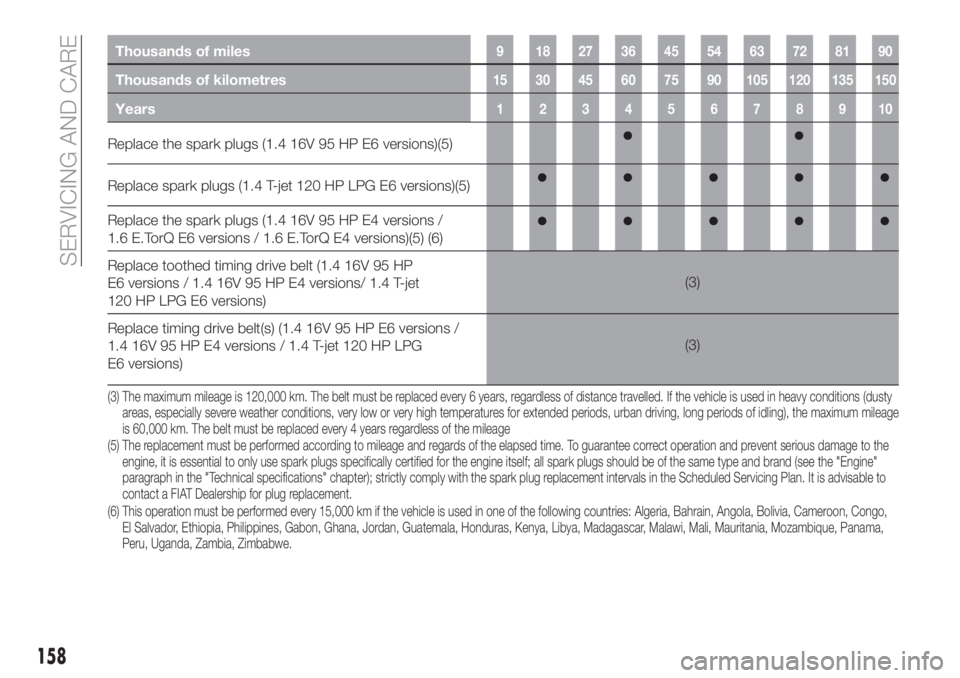
Thousands of miles9 182736455463728190
Thousands of kilometres15 30 45 60 75 90 105 120 135 150
Years12345678910
Replace the spark plugs (1.4 16V 95 HP E6 versions)(5)
Replace spark plugs (1.4 T-jet 120 HP LPG E6 versions)(5)
Replace the spark plugs (1.4 16V 95 HP E4 versions /
1.6 E.TorQ E6 versions / 1.6 E.TorQ E4 versions)(5) (6)
Replace toothed timing drive belt (1.4 16V 95 HP
E6 versions / 1.4 16V 95 HP E4 versions/ 1.4 T-jet
120 HP LPG E6 versions)(3)
Replace timing drive belt(s) (1.4 16V 95 HP E6 versions /
1.4 16V 95 HP E4 versions / 1.4 T-jet 120 HP LPG
E6 versions)(3)
(5) The replacement must be performed according to mileage and regards of the elapsed time. To guarantee correct operation and prevent serious damageto the
engine, it is essential to only use spark plugs specifically certified for the engine itself; all spark plugs should be of the same type and brand (see the "Engine"
paragraph in the "Technical specifications" chapter); strictly comply with the spark plug replacement intervals in the Scheduled Servicing Plan. It is advisable to
contact a FIAT Dealership for plug replacement.
(6) This operation must be performed every 15,000 km if the vehicle is used in one of the following countries: Algeria, Bahrain, Angola, Bolivia, Cameroon, Congo,
El Salvador, Ethiopia, Philippines, Gabon, Ghana, Jordan, Guatemala, Honduras, Kenya, Libya, Madagascar, Malawi, Mali, Mauritania, Mozambique,Panama,
Peru, Uganda, Zambia, Zimbabwe. (3) The maximum mileage is 120,000 km. The belt must be replaced every 6 years, regardless of distance travelled. If the vehicle is used in heavy conditions (dusty
areas, especially severe weather conditions, very low or very high temperatures for extended periods, urban driving, long periods of idling), the maximum mileage
is 60,000 km. The belt must be replaced every 4 years regardless of the mileage
158
SERVICING AND CARE
Page 161 of 252
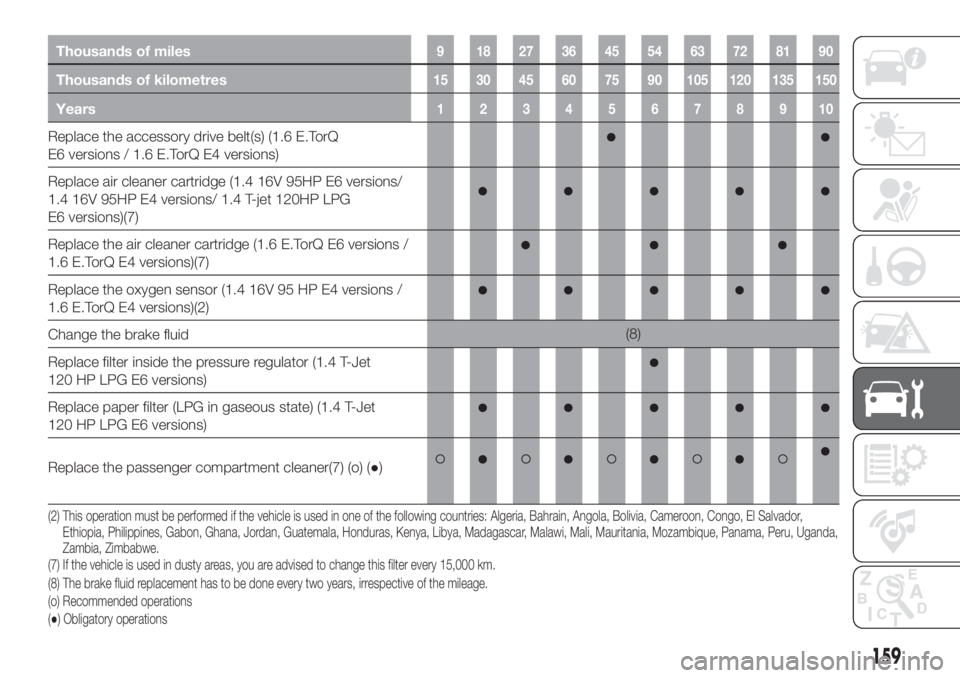
Thousands of miles9 182736455463728190
Thousands of kilometres15 30 45 60 75 90 105 120 135 150
Years12345678910
Replace the accessory drive belt(s) (1.6 E.TorQ
E6 versions / 1.6 E.TorQ E4 versions)
Replace air cleaner cartridge (1.4 16V 95HP E6 versions/
1.4 16V 95HP E4 versions/ 1.4 T-jet 120HP LPG
E6 versions)(7)
Replace the air cleaner cartridge (1.6 E.TorQ E6 versions /
1.6 E.TorQ E4 versions)(7)
Replace the oxygen sensor (1.4 16V 95 HP E4 versions /
1.6 E.TorQ E4 versions)(2)
Change the brake fluid(8)
Replace filter inside the pressure regulator (1.4 T-Jet
120 HP LPG E6 versions)
Replace paper filter (LPG in gaseous state) (1.4 T-Jet
120 HP LPG E6 versions)
Replace the passenger compartment cleaner(7) (o) (●)
(7) If the vehicle is used in dusty areas, you are advised to change this filter every 15,000 km. (2) This operation must be performed if the vehicle is used in one of the following countries: Algeria, Bahrain, Angola, Bolivia, Cameroon, Congo, El Salvador,
Ethiopia, Philippines, Gabon, Ghana, Jordan, Guatemala, Honduras, Kenya, Libya, Madagascar, Malawi, Mali, Mauritania, Mozambique, Panama, Peru, Uganda,
Zambia, Zimbabwe.
(8) The brake fluid replacement has to be done every two years, irrespective of the mileage.
(o) Recommended operations
(●) Obligatory operations
159
Page 163 of 252
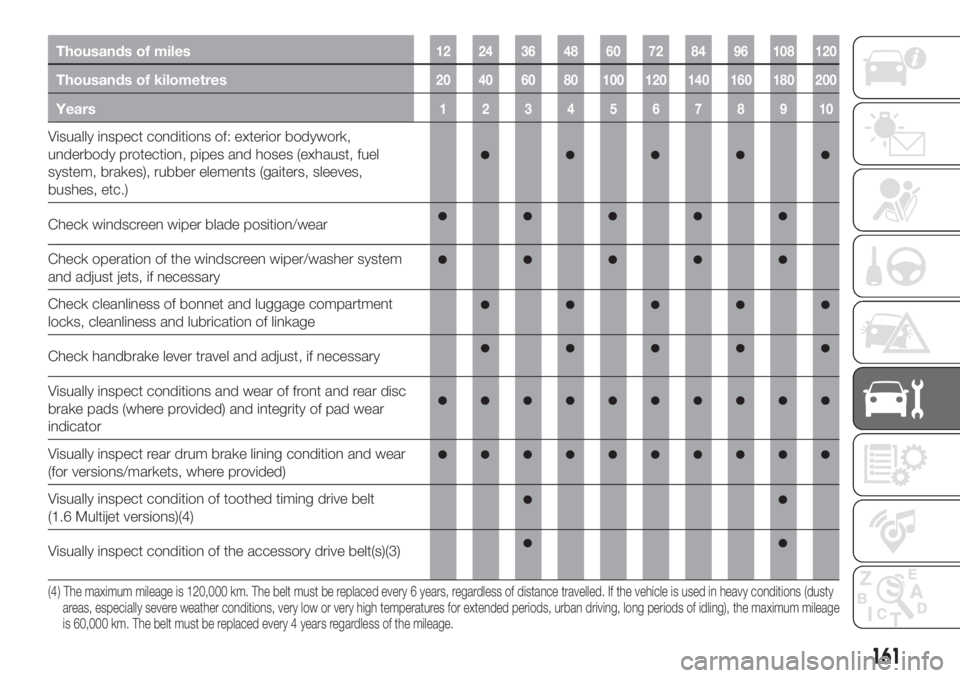
Thousands of miles12 24 36 48 60 72 84 96 108 120
Thousands of kilometres20 40 60 80 100 120 140 160 180 200
Years12345678910
Visually inspect conditions of: exterior bodywork,
underbody protection, pipes and hoses (exhaust, fuel
system, brakes), rubber elements (gaiters, sleeves,
bushes, etc.)
Check windscreen wiper blade position/wear
Check operation of the windscreen wiper/washer system
and adjust jets, if necessary
Check cleanliness of bonnet and luggage compartment
locks, cleanliness and lubrication of linkage
Check handbrake lever travel and adjust, if necessary
Visually inspect conditions and wear of front and rear disc
brake pads (where provided) and integrity of pad wear
indicator
Visually inspect rear drum brake lining condition and wear
(for versions/markets, where provided)
Visually inspect condition of toothed timing drive belt
(1.6 Multijet versions)(4)
Visually inspect condition of the accessory drive belt(s)(3)
(4 ) The maximum mileage is 120,000 km. The belt must be replaced every 6 years, regardless of distance travelled. If the vehicle is used in heavy conditions (dusty
areas, especially severe weather conditions, very low or very high temperatures for extended periods, urban driving, long periods of idling), the maximum mileage
is 60,000 km. The belt must be replaced every 4 years regardless of the mileage.
161
Page 164 of 252
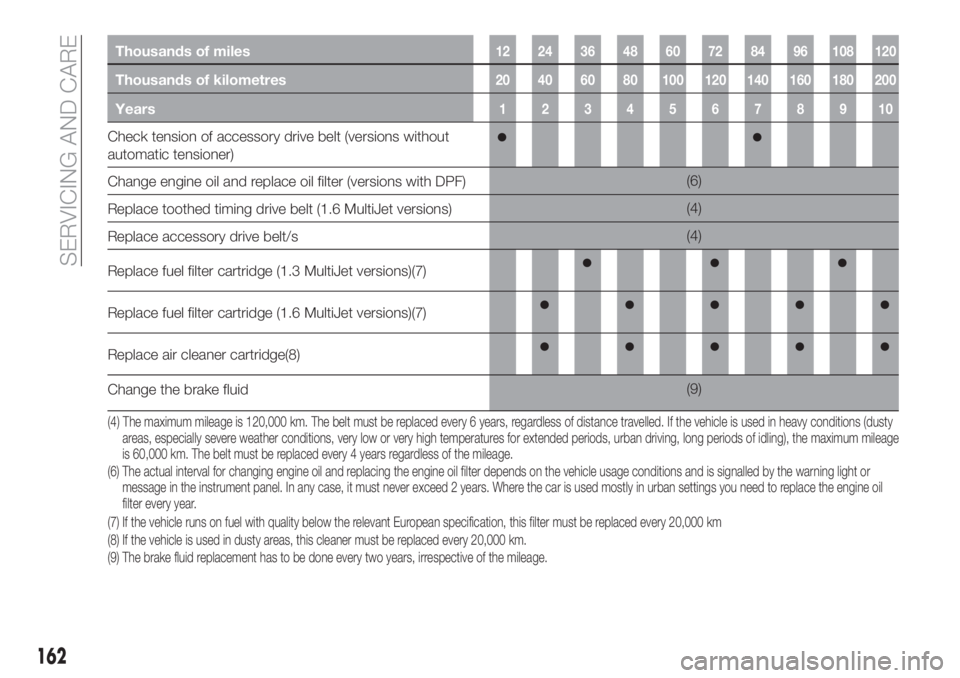
Thousands of miles12 24 36 48 60 72 84 96 108 120
Thousands of kilometres20 40 60 80 100 120 140 160 180 200
Years12345678910
Check tension of accessory drive belt (versions without
automatic tensioner)
Change engine oil and replace oil filter (versions with DPF)(6)
Replace toothed timing drive belt (1.6 MultiJet versions)(4)
Replace accessory drive belt/s(4)
Replace fuel filter cartridge (1.3 MultiJet versions)(7)
Replace fuel filter cartridge (1.6 MultiJet versions)(7)
Replace air cleaner cartridge(8)
Change the brake fluid(9)
(6) The actual interval for changing engine oil and replacing the engine oil filter depends on the vehicle usage conditions and is signalled by the warning light or
message in the instrument panel. In any case, it must never exceed 2 years. Where the car is used mostly in urban settings you need to replace the engine oil
filter every year. (4 ) The maximum mileage is 120,000 km. The belt must be replaced every 6 years, regardless of distance travelled. If the vehicle is used in heavy conditions (dusty
areas, especially severe weather conditions, very low or very high temperatures for extended periods, urban driving, long periods of idling), the maximum mileage
is 60,000 km. The belt must be replaced every 4 years regardless of the mileage.
(7) If the vehicle runs on fuel with quality below the relevant European specification, this filter must be replaced every 20,000 km
(8) If the vehicle is used in dusty areas, this cleaner must be replaced every 20,000 km.
(9) The brake fluid replacement has to be done every two years, irrespective of the mileage.
162
SERVICING AND CARE